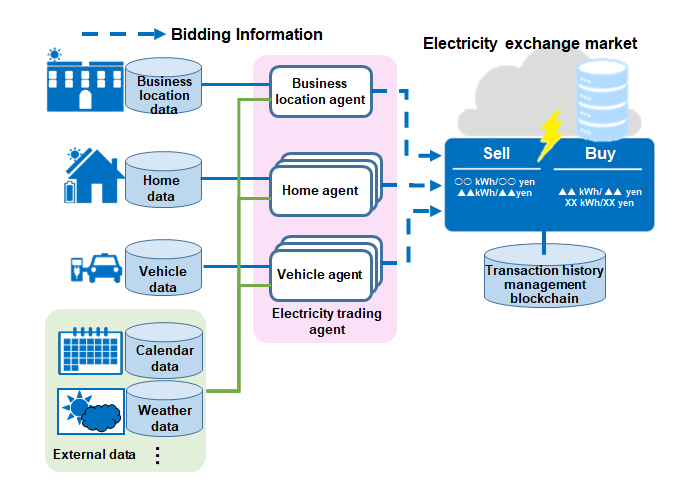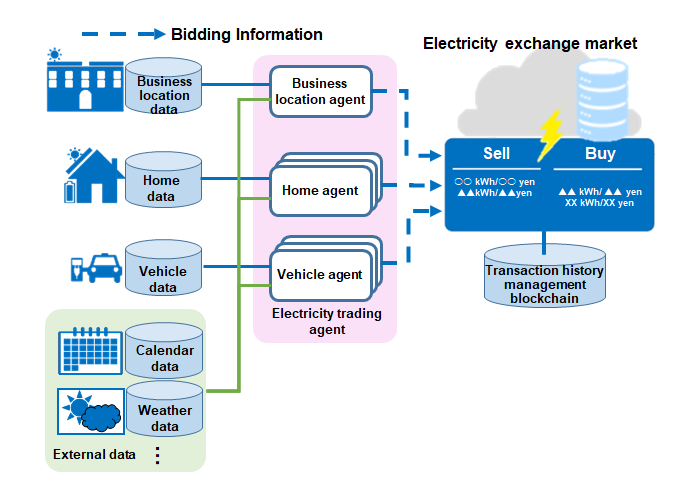November 13, 2020
Validity of P2P Electricity Transactions System Verified through Joint Test
Exploring Further Partnership toward Providing New Values
Toyota City, Japan, November 13, 2020―The Frontier Research Center of Toyota Motor Corporation (Toyota), the University of Tokyo (UTokyo), and TRENDE Inc., (TRENDE) concluded a joint test of a next-generation electricity trading system (P2P1 electricity transactions) that enables homes, businesses, and electrified vehicles connected to the electricity grid to autonomously trade electricity using blockchain2. The joint test was carried out from June 17, 2019 to August 31, 2020 at Toyota's Higashifuji Technical Center and in the surrounding area. The test verified the trading system to be an autonomous electricity supply and demand system that realizes efficient utilization of renewable energy and is effective in reducing electric bills, cutting the electric bills of the participating general households (including electrified vehicles) by approximately 9 percent. The system was also able to provide 43 percent of the electricity used for driving the electrified vehicles from renewable energy sources, thereby reducing CO2 emissions by 38 percent.
The recent test involved joint development and assessment of primarily the following three areas:
- An electricity trading market accessible by households, businesses, and electrified vehicles (PHEVs3) and in which prices fluctuate according to supply and demand
- A System that enables identification of the generation sources of the electricity being traded in the market and tracking of that electricity from generation sources to consumption
- Artificial intelligence (AI)-powered electricity trading agents that place orders to buy and sell electricity in an electricity exchange based on electrical consumption and forecasts of electrical power to be generated by solar panels
Utilizing the secure distributed power supply control infrastructure developed in the recent test, the three parties plan to consider providing a P2P electricity transactions service for electrified vehicle users and general household users, in the hopes that it will contribute to reducing electric bills and CO2 emissions, and furthermore to building disaster-resistant communities. While promoting the resolution of issues toward business installation, the three parties also plan to consider the possibility of expanding their system to other parts of Japan, as well as overseas by working with partner companies and universities abroad.
The recent joint test assessed the following:
Overview of Testing
The test involved a business location (Toyota's Higashifuji Technical Center) and 20 households of Toyota employees in the surrounding area. The three parties established an electricity exchange accessible by households and businesses participating in the test, and developed an AI-powered electricity forecasting/energy management system (an electricity trading agent) for households, businesses and electrified vehicles that forecasts electrical consumption and the electrical power to be generated by solar panels.
An electricity trading agent places orders to buy and sell electricity in this electricity exchange based on electrical consumption by homes and businesses and forecasts of electrical power to be generated by solar panels. Electricity transactions between individuals are implemented using a defined algorithm that matches buy and sell orders that are collected in the electricity exchange from each household and business. The test verified the economic advantage of having prosumers4, who generate electricity with their own distributed power supply, trade electricity with electricity consumers at prices that reflect supply and demand conditions, and assessed the feasibility of a two-way, automated electricity supply system that allows prosumers to have direct trading with other prosumers.
Development of electricity trading agent for vehicles
Among the electricity trading agents required for homes, businesses, and vehicles, Toyota was responsible for developing the electricity trading agent for vehicles. In developing this agent, Toyota made full use of its own big data related to vehicle driving. Taking into consideration the renewable energy ratio and electricity cost based on the forecasted distance to be driven, Toyota equipped the agent with a function for ordering electricity, a function for automatically charging or discharging according to the trading results, and a function for coordinating trading by the homes and vehicles.
| Testing period | June 17 2019 to August 31 2020 |
|---|---|
| Testing location | Toyota's Higashifuji Technical Center and the surrounding area |
| Monitors who participated in the testing |
|
| Electricity pricing | Pricing varies according to supply and demand volume. |
| Role of each party |
|
Results of the Test
The combined revenue and expenditure in August of all of the households participating in the P2P electricity transactions market test improved by 8.6 percent compared to those households purchasing electricity only from general power utility companies. It was verified that the revenue and expenditure of electricity consumers improved by 6.1 percent, those of prosumers improved by 18.0 percent, and those of electrified vehicles improved by 25.4 percent. Additionally, under the condition of unrestricted use of the electrified vehicles, 43 percent of the electricity used for driving came from renewable sources, reducing their CO2 emissions by 38 percent.
Electric bill improvement rates
| Participants in the test as a whole (20 households + 9 vehicles): 8.6% | PHEVs (9 vehicles) | |||||
|---|---|---|---|---|---|---|
| Electricity consumers (12 households + 6 vehicles): 6.1% | Prosumers (8 households + 3 vehicles): 18.0% | |||||
| Non-owners of PHEVs (6 households) | Owners of PHEVs (6 households) | Owners of solar panels only (2 households) | Owners of solar panels and secondary batteries (3 households) | Owners of solar panels and a PHEV (2 households) | Owners of solar panels, secondary batteries, and a PHEV (1 household) | |
 |  |  |  |  |  |  |
| 2.1% | 9.2% | 32.3% | 32.0% | 8.4% | 107.6%5 | 25.4% |
- 1
- This is an abbreviation for Peer to Peer, which is a mechanism for executing transactions wherein each terminal, called a node, communicates directly on an equal basis, instead of being dependent on a specific server or client.
- 2
- This is also called distributed ledger technology, which is used to build inexpensive databases in which all network participants share the ledger information in order to make it resistant to unauthorized modification.
- 3
- Stands for plug-in hybrid electric vehicles. Toyota Prius PHEVs were used in the test.
- 4
- This term was coined by merging the words "producer" and "consumer," and refers to an electricity consumer who is also a producer of electricity using self-owned power generation equipment.
- 5
- The number exceeded 100 percent because the revenue from selling electricity exceeded the cost of buying electricity, generating pure profit.
Related link:
The University of Tokyo, Toyota, and TRENDE to Begin Testing of Next-generation Electricity System
https://global.toyota/en/newsroom/corporate/28231367.html
For inquiries, please contact the following:
Frontier Research Center
E-mail address: xr-probot@mail.toyota.co.jp

